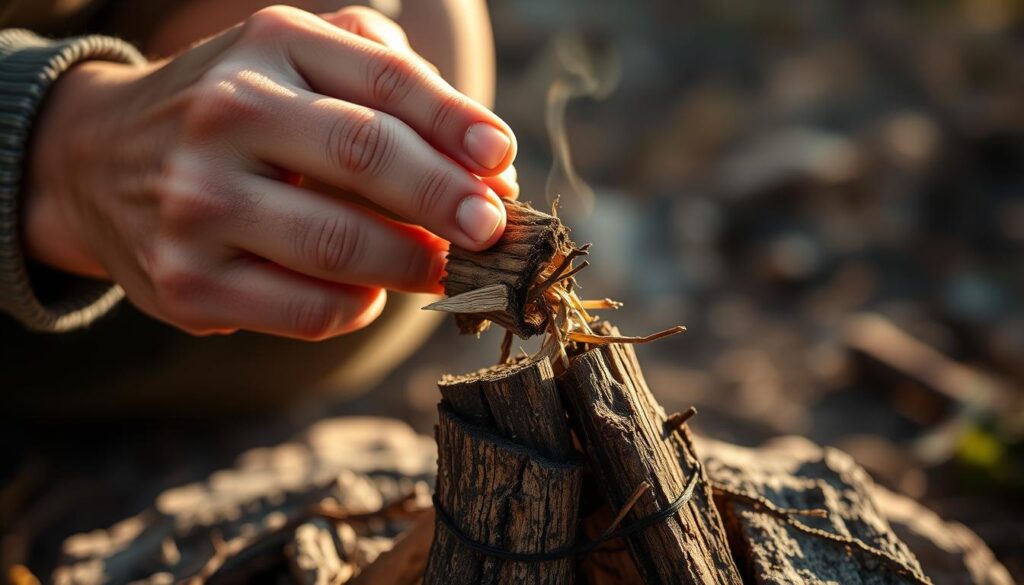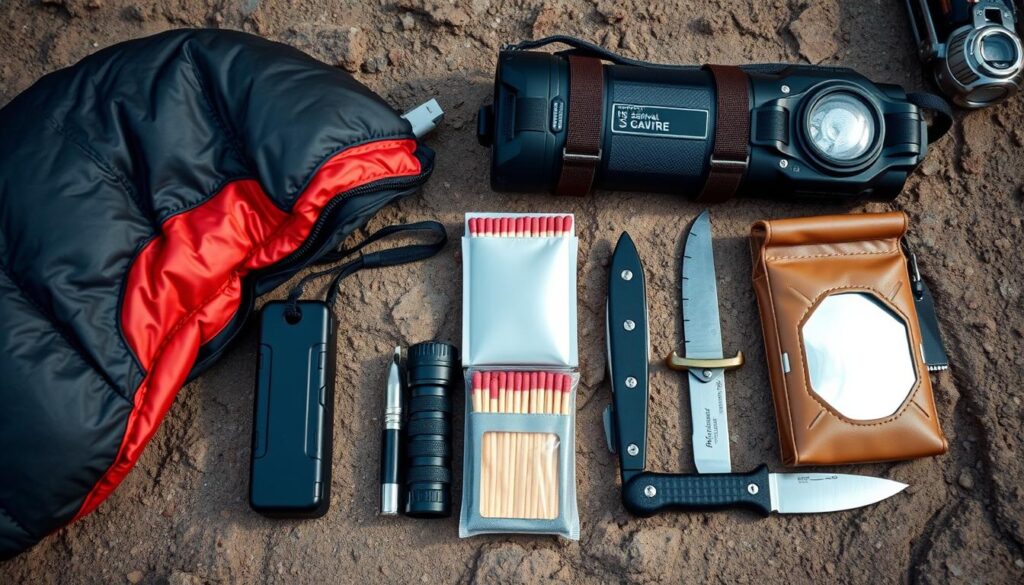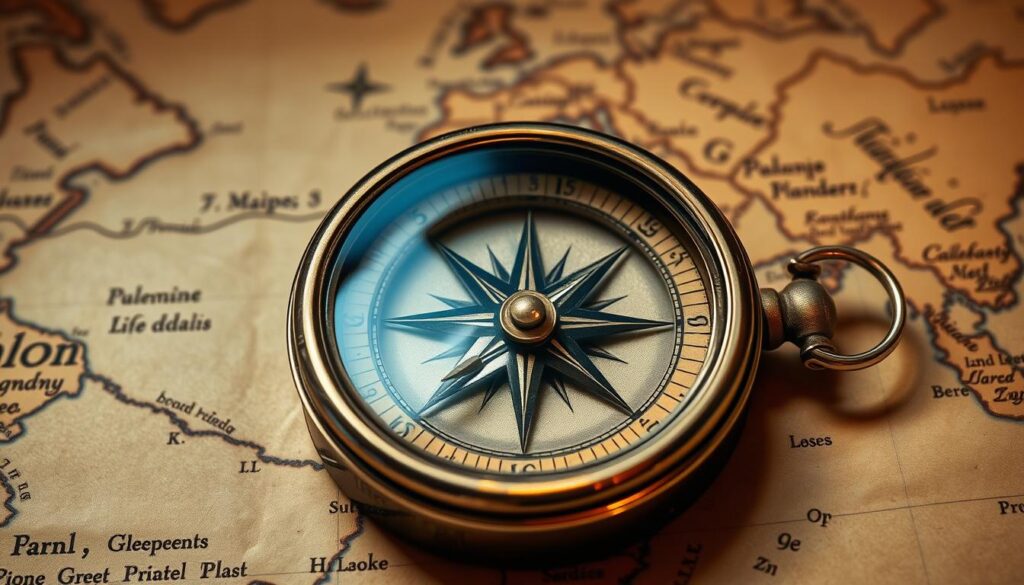Reflecting on my outdoor adventures, I see starting a fire as key. A good fire starter can turn a trip from bad to great. Here, I’ll show you how to start a fire easily with a fire starter, ready for your next camping or wilderness trip.
With a fire starter, you can reliably ignite a flame, even when it’s hard. This skill is vital for outdoor lovers. It lets you cook, stay warm, and signal for help. Follow this guide to start a fire with ease, knowing you’re ready for anything outdoors.
Key Takeaways
- Understand the importance of having a reliable fire starter for outdoor adventures.
- Learn the step-by-step process of starting a fire with a fire starter.
- Discover how to choose the right materials for starting a fire.
- Gain confidence in your ability to start a fire in various weather conditions.
- Be prepared for your next camping trip or wilderness excursion.
Understanding the Importance of Fire Starters
A good fire starter is more than just a convenience; it’s a necessity for outdoor enthusiasts. Whether you’re camping, hiking, or just enjoying a backyard barbecue, a reliable fire starter can make all the difference.
Fire starters are designed to simplify the process of starting a fire. They provide a quick and efficient way to ignite your campfire or fireplace. But what exactly is a fire starter, and why is it so important?
What is a Fire Starter?
A fire starter is a tool used to generate a spark or flame. This makes it easier to start a fire. One common type of fire starter is the ferrocerium rod, also known as a “ferro rod.” This man-made metallic alloy includes iron and cerium, which produces hot sparks when scraped with a rough surface. Ferrocerium rods are durable and waterproof, making them an excellent choice for outdoor use.
Benefits of Using Fire Starters
Using a fire starter offers several benefits, making outdoor activities more enjoyable. It saves time and effort. Trying to start a fire without a proper tool can be frustrating and time-consuming. With a fire starter, you can quickly and easily ignite your fire, even in damp or wet conditions.
Also, fire starters are often more reliable than matches or lighters, which can be affected by wind or moisture.
Having a reliable fire starter can also enhance your outdoor experience. Whether you’re camping in the wilderness or having a picnic in the park, a fire starter ensures that you can enjoy a warm fire, cook your meals, and stay safe. For campers, a waterproof fire starter is valuable, as it can withstand various weather conditions.
In summary, understanding the importance of fire starters and their benefits can greatly enhance your outdoor adventures. By choosing the right fire starter, such as a ferrocerium rod, you can ensure that starting a fire is no longer a challenge.
Types of Fire Starters Available
Fire starters come in many forms, each with its own special features. The right fire starter depends on what you like, where you are, and what you need. We’ll look at natural, synthetic, and DIY fire starters in this section.
Natural Fire Starters
Natural fire starters are found in nature and can start a fire. Examples include dry leaves, twigs, and certain bark types. Using natural materials is good for the environment because it reduces the need for made products.
Dry pine needles or shredded bark make great tinder. Foraging for natural fire starters can be rewarding, as long as it’s done sustainably.
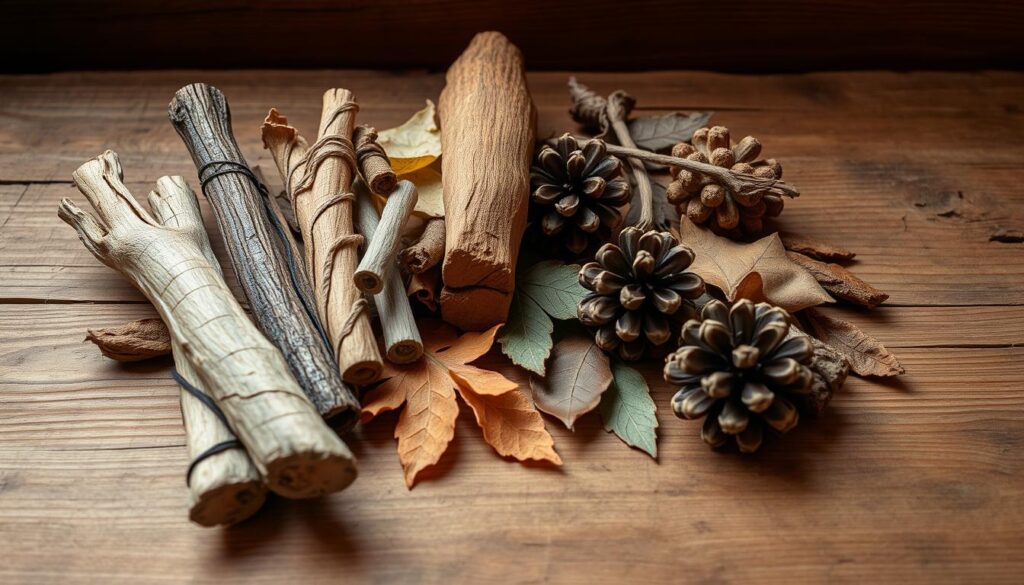
Synthetic Fire Starters
Synthetic fire starters are made products that start fires well. Examples include ferrocerium rods, lighters, matches, and magnesium blocks. Ferrocerium rods are popular for their reliability and durability in different weather.
| Type | Description | Advantages |
|---|---|---|
| Ferrocerium Rods | Generate sparks when scraped | Waterproof, reliable |
| Lighters | Produce a flame with a simple action | Convenient, easy to use |
| Magnesium Blocks | Shave magnesium to ignite | Long-lasting, easy to carry |
Commercial vs. DIY Options
Choosing between commercial and DIY fire starters is important. Commercial products are easy to find and use. But, DIY fire starters can be tailored to your needs and might save money.
For example, making a fire starter from cotton balls and petroleum jelly is simple and works well.
- Think about the materials you have.
- Pick the method that fits your needs.
- Make your fire starter as instructed.
How to Choose the Right Fire Starter
Choosing the right fire starter is key for a smooth fire-starting experience. The type you need depends on where and how you plan to use it.
Considerations for Outdoor vs. Indoor Use
First, think about whether you’ll use it outdoors or indoors. For camping or hiking, a waterproof or weather-resistant fire starter is a must. This is because outdoor environments can be unpredictable.
For indoor use, like in a fireplace, the needs are different. Yet, it’s important to pick a fire starter that’s efficient and easy to use.
Factors Affecting Performance
Several things can impact a fire starter’s performance. These include the fuel it’s meant to ignite, the environment it’s used in, and how easy it is to use. For example, in wet or windy conditions, you need a fire starter that works well.
The size and type of fire starter also matter. They affect how well it works and how convenient it is.
By thinking about these factors and understanding the differences between outdoor and indoor use, you can choose the right fire starter for your needs.
Preparing Your Fire Area
A well-prepared fire area is key to a successful fire start. Before starting, it’s vital to understand the importance of preparing the area. This is where your fire will be.
Selecting the Right Location
Finding the right spot for your fire is important. Look for a place that is clear of flammable materials like leaves and branches. The area should also be level and stable to prevent the fire from spreading.
- Ensure the area is away from overhanging branches and other fire hazards.
- Clear the area of any combustible materials.
- Choose a location that is protected from strong winds.
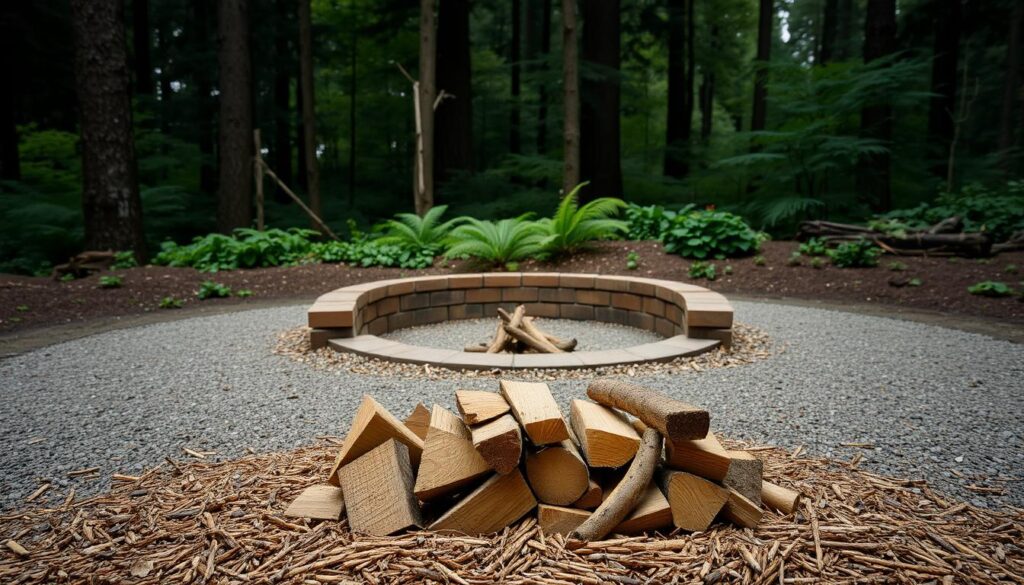
Safety Precautions to Take
Safety is always the first thing to think about when starting a fire. Keep your fire starter away from children, pets, and wildlife to avoid accidents. It’s also important to have a plan for putting out the fire when you’re done.
- Have a bucket of water or a fire extinguisher nearby.
- Monitor the fire at all times.
- Make sure to fully extinguish the fire before leaving it unattended.
By taking these steps and choosing the right spot, you can have a safe and fun fire starting experience. Remember, fire safety is everyone’s responsibility.
Gathering Materials for Your Fire
Starting a fire starts with the right materials. You need tinder, kindling, and logs. Having the right stuff is key to a good fire.
Best Kindling and Fuel Options
For kindling, look for dry, fluffy stuff that lights up fast. Dry grass, small twigs, and wood shavings are great. Tinder should be super flammable like dry leaves or small sticks. For fuel, you need bigger logs for a long burn.
For more tips on fire supplies, check out this resource on gathering fire-making supplies.
| Material | Description | Examples |
|---|---|---|
| Tinder | Highly combustible material that ignites easily | Dry leaves, bark, small dry sticks |
| Kindling | Dry, fluffy material that burns quickly | Dry grass, small twigs, wood shavings |
| Fuel | Larger logs that provide a sustained burn | Logs, branches, larger sticks |
Preparing and Arranging Materials
After gathering, prepare and arrange your materials. Start with tinder in the fire pit. Then, make a teepee with kindling around it. Leave space for air. Place logs around the kindling for a good fire.
By following these steps and using the right materials, you’ll start a successful fire. Always be safe when working with fire.
How to Use a Fire Starter Effectively
Using a fire starter is a reliable way to start a fire, whether camping or lighting a fireplace. It’s important to know how to use it right.
Step-by-Step Instructions
First, prepare your materials. Arrange sticks of kindling on top of dried leaves or twigs. This setup helps with airflow, which is key for starting the fire.
Then, hold the magnesium bar over the kindling with the flint strip up. Drag a knife across the strip to create sparks. It’s vital to hold the magnesium bar steady and strike the flint sharply to get a good spark.
As sparks hit the kindling, gently blow on them to spread the fire. Once the kindling burns well, add bigger logs to keep the fire going. Remember, starting a fire takes patience and might take a few tries.
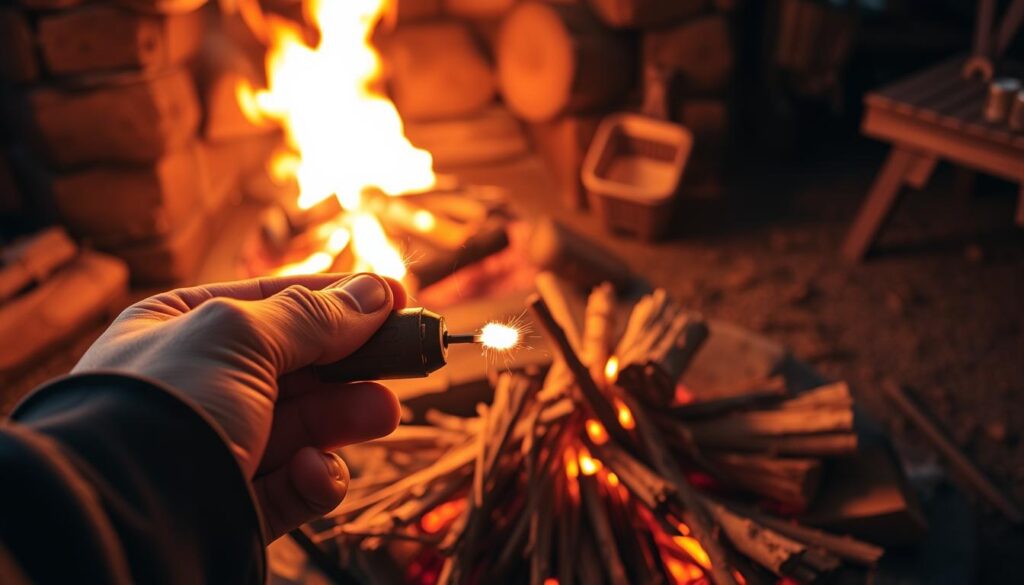
Common Mistakes to Avoid
A common mistake is not preparing the area well. Ensure the kindling is dry and the area is free from flammable materials.
Another error is not holding the magnesium bar correctly or striking the flint hard enough. Practice makes perfect, so don’t get discouraged if it takes a few attempts.
As
“The best way to get a fire going is to start with good tinder and kindling, and to be patient.”
This advice is true for using a fire starter. The quality of your materials and technique greatly affects the outcome.
Fire Starter Techniques for Different Scenarios
Starting a fire can change a lot depending on where you are. Whether you’re camping or lighting a fire at home, knowing the right way to start it is key.
For different places, you need different fire starting methods. For example, a ferro rod fire starter is great for camping. It works well even when it’s wet or windy.
Campfire vs. Fireplace
Starting a campfire is different from lighting a fireplace. When camping, you have to find dry materials like leaves and twigs. Fireplaces, on the other hand, usually have dry wood ready to go.
For a campfire, pick a safe spot away from branches and flammable things. Fireplaces are easier, using kindling and logs.
Lighting a Fire in Wet Conditions
Starting a fire when it’s wet can be tough, but it’s doable. A waterproof fire starter is a good choice for these situations.
To start a fire when it’s wet, look for dry spots. Use dry, fluffy stuff like cattail down. A ferro rod works well here, sparking even when wet.
| Scenario | Best Fire Starter | Tips |
|---|---|---|
| Campfire | Ferro Rod | Choose dry, sheltered spots |
| Fireplace | Matches or Lighters | Use dry kindling and logs |
| Wet Conditions | Waterproof Fire Starter | Look for dry material under protection |
Troubleshooting Common Fire Starting Issues
Even with the best fire starter sticks, starting a fire can be tough. Often, it’s because of simple problems that can be fixed easily.
Common Issues and Solutions
What to Do if the Fire Won't Ignite
First, check if your tinder is dry. Moisture makes it hard to start a fire. So, it’s key to keep tinder dry.
Also, make sure you’re getting enough sparks. Use your fire starter stick right to get more sparks. And, make sure your kindling is set up for good airflow. Oxygen is key for a fire to start and stay burning.
“A well-structured fire pit with adequate airflow is essential for a fire to ignite and burn steadily.”
Ensuring Your Fire Burns Steadily
After lighting your fire, keeping it steady is the next step. You need the right mix of airflow and fuel. Too little airflow makes it smolder, too much makes it burn fast. A steady fire needs good airflow.
To keep the fire steady, start with kindling in a teepee or crisscross pattern. This lets air flow well. Once it’s burning well, add bigger logs. Watch the fire and adjust airflow to keep it steady.
By using these tips, you can solve common fire starting problems. Whether camping or by a fireplace, a good fire makes everything better.
Maintaining Your Fire Once Started
Starting a fire is just the first step. Keeping it going is the real challenge. It requires careful attention and a focus on safety. As I tend to my fire, I aim for a steady, efficient burn.
How to Add Fuel Properly
To keep the fire alive, adding fuel correctly is essential. I start with small twigs and move to bigger logs as it grows. It’s important to arrange the fuel for good airflow, ensuring the fire breathes well. Proper fuel addition is key to maintaining a consistent flame.
When adding fuel, I avoid smothering the fire. Instead, I add small amounts at a time. This lets me adjust based on the fire’s size and surroundings.
Monitoring Fire Safety
Fire safety is as critical as keeping the fire burning. I watch the flames closely, noticing any changes. I’m mindful of wind, nearby flammable materials, and the fire’s containment. A bucket of water or a fire extinguisher should always be nearby.
| Fire Safety Tips | Description |
|---|---|
| Monitor Wind Direction | Be aware of the wind direction to prevent sparks from igniting nearby objects. |
| Keep a Safe Distance | Ensure the fire is at a safe distance from flammable materials and overhanging branches. |
| Have a Fire Extinguisher Ready | Keep a fire extinguisher or a bucket of water nearby to extinguish the fire if it gets out of control. |
By following these tips, I can enjoy my fire safely. Maintaining a fire is not just about keeping it burning. It’s also about being responsible and aware of our surroundings.
Eco-Friendly Fire Starting Options
Starting a fire doesn’t have to harm the environment. I’ve found several eco-friendly ways to do it. As someone who loves the outdoors, I’ve learned that making a fire can be both effective and kind to the planet.
Using Natural Materials
One great way to start a fire eco-friendly is with natural materials. Dry leaves, twigs, and other organic stuff can make a homemade fire starter. I often find dry pine needles, small sticks, and other flammable things in nature for kindling.
Benefits of Natural Materials: Using natural materials cuts down on synthetic or chemical fire starters. This method not only reduces environmental harm but also connects us to traditional fire starting ways.
Reducing Smoke and Pollution
Choosing the right fire starter can greatly cut down smoke and pollution. I like fire starters that burn cleaner and make less smoke. This improves air quality and makes starting a fire more fun.
- Opt for fire starters made from natural, biodegradable materials.
- Consider using a fire starter that is designed to reduce smoke output.
- Ensure that your fire is well-ventilated to minimize the production of pollutants.
By using these eco-friendly fire starting options, we can enjoy fires without harming the environment.
Fire Safety Tips for Beginners
For beginners, knowing fire safety tips is key to avoid accidents. When starting a fire, being careful is important. It can turn a safe and fun experience into a dangerous one.
Essential Gear and Tools
Having the right gear and tools is vital for fire safety. You’ll need a fire extinguisher or a bucket of water to put out fires. A fire starter kit is also essential. It has everything you need to start a fire safely, like kindling, tinder, and a fire starter.
It’s also smart to have a first-aid kit nearby. It can help with minor injuries. Being ready with the right equipment can greatly lower the risk of accidents.
Understanding Fire Regulations
Knowing local fire regulations is also key. This means understanding any fire restrictions in your area, like burn bans or fire rules. Knowing these rules helps you avoid legal trouble and keeps everyone safe.
By learning about local fire rules and having the right gear, you can have a safe and fun time starting fires. Always check local fire restrictions before you start a fire. Rules can change often because of weather.
Conclusion: Mastering Fire Starting Skills
Mastering fire starting is a key skill for outdoor enthusiasts. It involves understanding the importance of fire starters and choosing the right one. Each step is vital for a safe and enjoyable outdoor experience.
Practical Takeaways
One of the most important lessons is preparing your fire area and gathering the right materials. Choosing the right location and taking safety precautions can prevent accidents. Learning to use a fire starter well and solving common problems boosts your confidence.
Continuing Your Journey
For those new to fire starting, keep practicing and improving your skills. Whether camping, hiking, or having a backyard fire, starting a fire safely is essential. As you get better, you’ll enjoy nature more and be ready for emergencies.
FAQ
What is the best fire starter for camping?
For camping, a waterproof fire starter is best. Options include ferrocerium rods or lighters. They work well in different weather.
How do I make a homemade fire starter?
You can make a fire starter at home. Use dryer lint, wax, and twine. Or try cotton balls and petroleum jelly.
What are the different types of fire starters available?
Fire starters come in many types. You can choose from natural like flint and steel, synthetic like lighters, or commercial like fire starter sticks.
How do I choose the right fire starter for my needs?
Think about where you’ll use it, like outdoors or indoors. Also, consider how well it works, how long it lasts, and how easy it is to use.
What materials do I need to start a fire?
You need tinder, kindling, and fuel. Dry leaves, twigs, and logs are good choices.
How do I prepare my fire area for a campfire?
Choose a safe spot, away from flammable things. Build a fire ring or pit for safety.
What are some common mistakes to avoid when using a fire starter?
Don’t forget to prepare the area and use dry materials. Always watch for fire safety.
How do I light a fire in wet conditions?
Use a waterproof fire starter in wet weather. Dry your materials and build a fire shelter if needed.
What should I do if my fire won’t ignite?
Check if your materials are dry. Try a different fire starter or technique if needed.
How do I maintain my fire once it’s started?
Add fuel carefully and keep an eye on the fire. Make sure to fully extinguish it when done.
Are there eco-friendly fire starting options available?
Yes, use natural materials and choose sustainable fire starters. This reduces smoke and pollution.
What are some essential fire safety tips for beginners?
Have the right tools and know the rules. Be careful when starting and keeping a fire.

